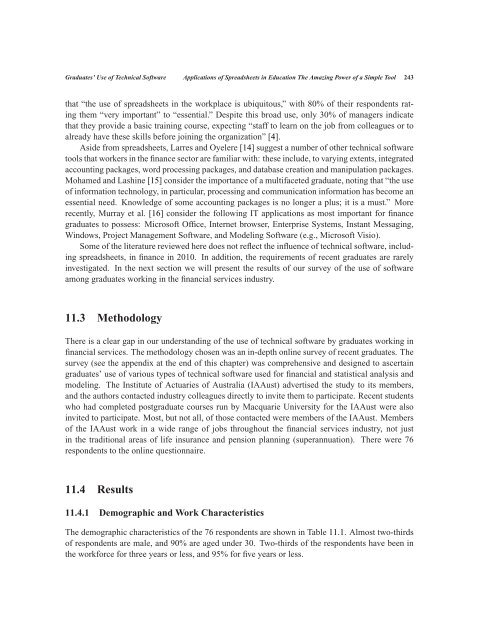chapter 3 - Bentham Science
chapter 3 - Bentham Science
chapter 3 - Bentham Science
Create successful ePaper yourself
Turn your PDF publications into a flip-book with our unique Google optimized e-Paper software.
Graduates’ Use of Technical Software Applications of Spreadsheets in Education The Amazing Power of a Simple Tool 243<br />
that “the use of spreadsheets in the workplace is ubiquitous,” with 80% of their respondents rating<br />
them “very important” to “essential.” Despite this broad use, only 30% of managers indicate<br />
that they provide a basic training course, expecting “staff to learn on the job from colleagues or to<br />
already have these skills before joining the organization” [4].<br />
Aside from spreadsheets, Larres and Oyelere [14] suggest a number of other technical software<br />
tools that workers in the finance sector are familiar with: these include, to varying extents, integrated<br />
accounting packages, word processing packages, and database creation and manipulation packages.<br />
Mohamed and Lashine [15] consider the importance of a multifaceted graduate, noting that “the use<br />
of information technology, in particular, processing and communication information has become an<br />
essential need. Knowledge of some accounting packages is no longer a plus; it is a must.” More<br />
recently, Murray et al. [16] consider the following IT applications as most important for finance<br />
graduates to possess: Microsoft Office, Internet browser, Enterprise Systems, Instant Messaging,<br />
Windows, Project Management Software, and Modeling Software (e.g., Microsoft Visio).<br />
Some of the literature reviewed here does not reflect the influence of technical software, including<br />
spreadsheets, in finance in 2010. In addition, the requirements of recent graduates are rarely<br />
investigated. In the next section we will present the results of our survey of the use of software<br />
among graduates working in the financial services industry.<br />
11.3 Methodology<br />
There is a clear gap in our understanding of the use of technical software by graduates working in<br />
financial services. The methodology chosen was an in-depth online survey of recent graduates. The<br />
survey (see the appendix at the end of this <strong>chapter</strong>) was comprehensive and designed to ascertain<br />
graduates’ use of various types of technical software used for financial and statistical analysis and<br />
modeling. The Institute of Actuaries of Australia (IAAust) advertised the study to its members,<br />
and the authors contacted industry colleagues directly to invite them to participate. Recent students<br />
who had completed postgraduate courses run by Macquarie University for the IAAust were also<br />
invited to participate. Most, but not all, of those contacted were members of the IAAust. Members<br />
of the IAAust work in a wide range of jobs throughout the financial services industry, not just<br />
in the traditional areas of life insurance and pension planning (superannuation). There were 76<br />
respondents to the online questionnaire.<br />
11.4 Results<br />
11.4.1 Demographic and Work Characteristics<br />
The demographic characteristics of the 76 respondents are shown in Table 11.1. Almost two-thirds<br />
of respondents are male, and 90% are aged under 30. Two-thirds of the respondents have been in<br />
the workforce for three years or less, and 95% for five years or less.

















